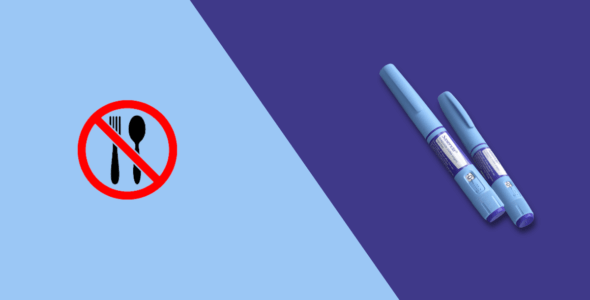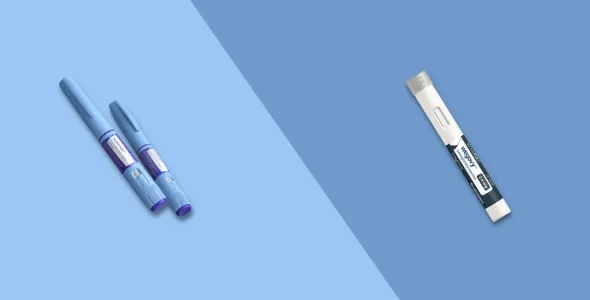How much does Saxenda cost with and without insurance? 2025 update
Starting a weight management journey can be life-changing, and for many, Saxenda (liraglutide) offers a promising path. However, a common and significant hurdle is affording the medication.
Key highlights
- Saxenda (liraglutide) is an FDA-approved subcutaneous injection used for chronic weight management in adults with obesity or overweight and related health conditions.
- Without insurance, Saxenda costs about $1,350 per month. With some insurance plans and savings programs, the cost can be as low as $25 per month.
- The pharmacy you choose and where you live can affect how much you pay out of pocket for Saxenda.
- Without insurance, discount cards from websites like GoodRx can reduce the cost by 20% or more.
- Buying a 90-day supply or using a mail-order pharmacy can lower overall costs.
Saxenda is an FDA-approved glucagon-like peptide-1 (GLP-1) receptor agonist used for chronic weight management in adults and adolescents with obesity or weight-related conditions.
Saxenda’s high cost makes it hard for many people to afford long-term treatment. This creates stress and tough choices, like cutting back on other essentials or stopping the medication.
Key factors that affect Saxenda’s price include your insurance coverage, dosage amount, and whether you use discounts or savings programs. Pharmacy location and supply size (30-day vs. 90-day) can also affect the price.
Keep reading for detailed information on Saxenda cost, including retail price, how insurance affects it, and ways to save money with coupons, savings cards and financial assistance programs.
How much does Saxenda cost?
The list price of Saxenda is the price set by the manufacturer before any insurance, discounts, or rebates are applied. According to the manufacturer’s website, the list price for Saxenda is $1,349. It’s not usually what most people end up paying.
The estimated retail price for a one-month supply of Saxenda (a five-pack) is around $1,300 to $1,700, depending on the pharmacy and location.
However, the final out-of-pocket (OOP) cost for you may be much lower if you:
- Use insurance or a savings card
- Qualify for patient assistance
- Shop around using coupon websites (like GoodRx)
Prices may vary by pharmacy and region, so comparing options before you buy is a good idea.
Factors influencing retail price
Several factors can affect how much you pay for Saxenda at the pharmacy, including:
- Prices can vary a lot between pharmacies. Big retail chains, smaller local pharmacies, and online/mail-order services may all charge different amounts for the same medication. It’s a good idea to shop around and compare prices using websites like GoodRx or SingleCare.
- Where you live also matters. Saxenda prices can differ by state, city, or region because of local supply, demand, and pharmacy pricing strategies.
- Buying a 90-day supply (if allowed) may reduce the cost per month compared to a 30-day supply. Some insurance plans and pharmacies offer discounts for larger quantities, so always check if this option is available to save more.
Dosage and duration
Saxenda is FDA-approved for use in adolescents (12-17 years old) who meet the following requirements:
- Those who weigh over 132 pounds and are considered obese based on adult body mass index (BMI)
- Obese, or overweight, with at least one weight-related condition such as high blood pressure, type 2 diabetes, or high cholesterol
Saxenda must be used in conjunction with a reduced-calorie diet and increased physical activity.
Saxenda comes as a prefilled, multi-dose pen (3 ml) that contains 18 mg of medicine. When you start using it, one pen will last for 17 days. A full pack, which has five pens, will last for about six weeks. Be sure to rotate injection sites each day to prevent injection site reactions.
Each Saxenda pen can give you one of the five doses:
- 0.6 mg
- 1.2 mg
- 1.8 mg
- 2.4 mg
- 3 mg
Starting dose
The recommended initial dose of Saxenda for chronic weight management is 0.6 mg once daily for the first week to help your body adjust to the medication and minimize potential gastrointestinal side effects.
Weekly titration
The specific weekly titration schedule is as follows:
- Week 1: 0.6 mg once daily
- Week 2: 1.2 mg once daily
- Week 3: 1.8 mg once daily
- Week 4: 2.4 mg once daily
- Week 5 and beyond (maintenance dose): 3.0 mg once daily
Maintenance dose
After you finish the 4-week dose increase and reach the full 3 mg daily dose, one Saxenda pen will last 6 days. A pack of five pens will last 30 days.
Maximum daily dose
The maximum recommended daily dose for adults is 3 mg.
Taking more than 3 mg per day is not recommended. It won’t lead to more weight loss and may increase the risk of side effects like nausea, vomiting, constipation, or low blood sugar.
Never change your Saxenda dose without medical advice from your healthcare provider. The dosage increase follows a titration schedule, a gradual step-by-step plan designed to help your body adjust and reduce the risk of side effects.
Saxenda cost without insurance
The list price for a 30-day supply of Saxenda is approximately $1,349.02. Without insurance, the average monthly cost is around $1,300.
Saxenda cost with insurance
Insurance coverage for this medication can differ depending on the plan, but most insurance plans don’t cover weight loss treatments. Some plans may cover Saxenda, while others may not, so many patients might have to pay the full price. A month’s supply of Saxenda costs about $1,300 without insurance.
When you have insurance, the out-of-pocket cost for Saxenda depends on your deductible, copay or coinsurance, and where Saxenda is placed on your plan’s formulary (drug tier).
Many commercial plans, when used with the Saxenda Savings Card, can reduce your cost to as little as $25 per month for a 30-day supply. Over 80% of patients pay $25 or less, according to the manufacturer. To receive insurance coverage for Saxenda, your doctor may need to submit a prior authorization request, and you may need to try step therapy first.
The coverage for drugs varies by insurance plan. Some plans may cover Saxenda, but it is not typically covered by Medicare Part D for weight loss.
Deductibles are the amount of money you must pay each year for your healthcare or prescriptions before your insurance starts to help cover the costs. For example, if your deductible is $1,000, you will need to pay that amount out of your pocket for approved medical expenses (like Saxenda) before your insurance begins to pay its share. Once your deductible is met, you may only need to pay a copay or coinsurance for the rest of the year.
Copay and coinsurance are two ways you may share the cost of your medicine after you’ve met your deductible:
- A copay is a fixed fee you pay for your medicine, for example, $50 each time you fill Saxenda.
- Coinsurance is a percentage of the total cost; for example, you might pay 20% of the price of Saxenda.
Your monthly cost depends on which of these options your insurance uses and the total cost of the medication.
Drugs are placed into tiers by insurance plans. Saxenda may be in a non-preferred brand tier, which usually means higher out-of-pocket costs.
To find out if your insurance covers Saxenda, contact your plan’s pharmacy benefits department directly. You can usually find the phone number on the back of your insurance card.
Private/commercial Insurance
Some private or employer-based insurance plans may cover Saxenda, especially if they recognize obesity as a chronic medical condition. However, coverage is not automatic and often comes with specific requirements.
Most plans require prior authorization, which means your doctor must send documents to your insurance company showing why Saxenda is medically necessary for you. Approval is needed before you can get the medication covered.
Some insurance plans require step therapy, which means you may need to try other, usually cheaper, weight loss treatments or medications first. If those don’t work, Saxenda might be approved next.
Always review your plan’s Summary of Benefits and Coverage (SBC) and formulary (drug list). These documents explain what’s covered, what tier Saxenda is on, and what your costs might be.
If you’re eligible and have commercial insurance, you may be able to get Saxenda for as low as $25 per month using the NovoCare Savings Card. Visit www.novocare.com to apply.
Medicare (Part D & Medicare Advantage Plans)
Medicare Part D plans typically do not cover medications used only for weight loss, like Saxenda, due to current federal regulations.
This lack of coverage creates a major barrier for many seniors who may benefit from treatment. Advocacy efforts are ongoing to push for policy changes that would allow coverage of anti-obesity medications under Medicare in the future.
Medicaid
Coverage for Saxenda under Medicaid is different in every state. Some states may cover it with strict rules, while others may not cover it at all.
To find out if you qualify, check your state’s Medicaid website or contact your local Medicaid office. They can tell you about coverage, requirements like prior authorization, and what steps you need to take.
Who should not take Saxenda? Contraindications and warnings
Saxenda comes with a box warning about the possible risk of thyroid tumors. People with a personal or family history of medullary thyroid cancer (MTC) or multiple endocrine neoplasia type 2 (MEN 2) should avoid this medication.
Saxenda can increase heart rate, which may cause problems for people with heart disease or high blood pressure. It also carries risks like pancreatitis, gallbladder disease, kidney problems, and suicidal thoughts or behaviors. Low blood sugar (hypoglycemia) is another risk, especially for people taking other diabetes medications.
Get medical help right away if your side effects last or get worse. You should seek emergency care if you have signs of an allergic reaction, like hives, swelling in your face or throat, or trouble breathing.
Always tell your doctor or pharmacist about all over-the-counter medications, supplements, and vitamins you take.
Boxed warning
Saxenda (liraglutide) carries an FDA-boxed warning due to the risk of thyroid C-cell tumors or thyroid cancer observed in animal studies.
In rodent studies, GLP-1 receptor agonists like Saxenda and Wegovy caused thyroid C-cell tumors, including medullary thyroid carcinoma (MTC).
It’s not known whether these findings apply to humans, but the potential risk cannot be ruled out.
Do NOT use Saxenda if:
- You have a personal or family history of MTC, a rare type of thyroid cancer
- You have been diagnosed with Multiple Endocrine Neoplasia syndrome type 2 (MEN 2), a genetic condition linked to endocrine tumors
- Serious allergic reaction to liraglutide or any of the ingredients in Saxenda.
- Are pregnant or planning to become pregnant
- Are breastfeeding, as it is not known if Saxenda passes into breast milk
- Have serious kidney or liver problems
How to save on Saxenda in 2025
Here are some strategies that can be used to save on Saxenda:
Saxenda Savings Card (Novo Nordisk’s NovoCare®)
Novo Nordisk, the manufacturer of Saxenda, offers a Saxenda savings card program, which is for eligible commercially insured patients who may pay as little as $25 per 30-day prescription.
This card can be used at participating pharmacies. It is not valid for patients on government insurance like Medicare, Medicaid, or other federal/state healthcare programs.
To get the Saxenda Savings Card, go to the official NovoCare® website at www.novocare.com.
Here’s how to apply in simple steps:
- On the homepage, click on “Savings and Support.”
- Choose Saxenda from the list of medicines.
- Click on “Get Savings Card” or “Activate Card.”
- Fill out the form with your information, including insurance details if needed.
- Submit the form to see if you’re eligible.
If approved, you can download the savings card right away and show it at your pharmacy to save on your prescription.
Compounded liraglutide
Compounded liraglutide is made by compounding pharmacies, which mix medications tailored to individual needs, often when the original drug is unavailable or too expensive. Unlike FDA-approved medications like Saxenda or Victoza, compounded drugs are not reviewed for safety, effectiveness, or quality by the FDA. This means there could be risks, such as incorrect strength, contamination, or improper storage.
If you’re considering compounded liraglutide, it’s important to speak with a healthcare professional. They can help you weigh the risks and benefits and ensure you’re using a product from a reputable source if it’s appropriate for you.
Patient assistance programs (PAPs)
Patient assistance programs (PAPs) are special programs that help people who don’t have insurance or don’t have enough coverage pay for their medicines. These programs are usually free and are based on how much money you make.
To see if you qualify, visit the drug company’s patient help website, like Novo Nordisk for Saxenda, or check trusted websites like NeedyMeds.org or Partnership for Prescription Assistance. They can guide you on how to apply and what documents you’ll need.
90-day supplies
Getting a 3-month supply of your medicine can save you money and time. If your insurance allows it and your pharmacy offers it, the cost per month is often lower than buying it one month at a time.
It also means fewer trips to the pharmacy, which is more convenient, especially if you’re using the medicine long-term.
Pharmacy discounts and coupons
Free discount programs like GoodRx, SingleCare, and WellRx may help lower out-of-pocket costs if you’re paying cash for the medication.
You usually can’t use these coupons with your health insurance; you use them instead of insurance. Always check which gives you the better price.
Prices can vary, so it’s worth comparing across all prescription drug discount websites and local pharmacies.
Show the coupon at the pharmacy counter and ask for the lowest price. Some pharmacies even offer their loyalty programs or will match prices from other stores to help you save more.
Mail-order pharmacies
Mail-order pharmacies can save you money, especially if you order a 90-day supply. Many insurance plans have a preferred mail-order service that offers lower prices compared to local pharmacies.
It’s also convenient. Your medicine gets delivered right to your home, so you don’t have to make extra trips. Check with your insurance provider to see if mail-order pharmacies are covered and how to get started.
HSAs/FSAs
If you have a Health Savings Account (HSA) or Flexible Spending Account (FSA), you can use that money to help pay for Saxenda and other medical costs. These accounts use pre-tax dollars, which means you save money by not paying taxes on the amount you spend.
Using your HSA or FSA can lower your overall out-of-pocket costs and help make your medication more affordable. Just be sure to keep receipts and check if Saxenda is considered a qualified expense under your plan.
Saxenda vs. alternative weight loss drugs: Cost comparison
Ask your healthcare provider if other GLP-1 meds (Wegovy, Ozempic, or even generic liraglutide) might be an option, knowing they may have different indications, dosing, and side effects.
Saxenda vs. Wegovy
Wegovy is a once-a-week prescription medication approved for long-term weight loss in people 12 and older. Some people find Wegovy weekly injections easier to use than Saxenda, and it may help you lose more weight.
Saxenda (liraglutide) and Wegovy (semaglutide) are GLP-1 receptor agonists that help reduce appetite and food intake.
Saxenda costs around $1,800 per month for a five-pen monthly supply. Wegovy ranges from $1,349 to $1,835 per month, with typical cash prices around $1,349–1,83. Both drugs offer manufacturer savings cards that can reduce your monthly cost to as low as $25 with insurance.
Saxenda vs. Ozempic (off-label)
Saxenda contains liraglutide, while Ozempic contains the active ingredient semaglutide, a different but similar GLP-1 receptor agonist. Semaglutide is generally more effective and longer-acting.
Saxenda is FDA-approved specifically for weight management. Ozempic is approved for type 2 diabetes; it’s often used off-label for weight loss.
Saxenda and Ozempic are both GLP‑1 receptor agonists, meaning they work by mimicking a natural hormone that helps control appetite and blood sugar. However, there are key differences between them. Saxenda is FDA-approved specifically for weight loss and is taken daily by injection, while Ozempic is approved for type 2 diabetes but is often used off-label for weight loss and is injected just once a week. In terms of effectiveness, Ozempic tends to show greater weight loss results, about 12–16% of body weight lost over time, compared to 6–8% with Saxenda.
When it comes to cost, Ozempic is generally cheaper. The average retail price for Saxenda is around $1,300 per month, while Ozempic is typically $900–$950 monthly. With insurance and manufacturer savings cards, both medications may be available for as little as $25 per month, but this depends on your coverage and eligibility. Overall, Ozempic may offer more convenience and better results at a lower price, but Saxenda remains a strong option for those specifically seeking an FDA-approved weight-loss treatment.
Saxenda vs. Zepbound
Both Saxenda and Zepbound are injectable medications designed for weight management, but they differ in dosage schedule and effectiveness. Saxenda contains liraglutide and is administered daily, while Zepbound (tirzepatide) is injected once weekly, offering a more convenient schedule.
In terms of weight loss, clinical trials show Zepbound often delivers higher results, with patients typically losing 15–20% of body weight over about 72 weeks, compared to around 8% with Saxenda over 56 weeks.
When comparing costs, Saxenda’s list price in the U.S. is about $1,350 per month, while Zepbound’s list price is slightly lower, around $1,060–1,086 per month.
For self-paying patients, Zepbound’s cost can be further reduced using manufacturer savings cards, which lower the cost for eligible patients to $499/month without insurance. Both drugs also offer savings through commercial insurance plans, where copays may be reduced to $25/month.
Saxenda vs. Mounjaro (off-label)
Saxenda and Mounjaro (used off-label for weight loss) are both injectable medications that help manage weight by mimicking natural hormones to control appetite and digestion. Saxenda contains liraglutide and is FDA-approved specifically for weight loss.
Mounjaro, which contains tirzepatide, is approved for type 2 diabetes but is commonly used off-label for weight loss. It is taken once a week, offering greater convenience.
In terms of effectiveness, Mounjaro has shown superior results, with clinical trials reporting 15–20% weight loss over about 72 weeks, compared to Saxenda’s average 6–8% weight loss over one year.
When it comes to cost, Saxenda typically costs around $1,349 per month without insurance, while Mounjaro is usually less expensive, costing an average of about $1,023 per month. However, with insurance and manufacturer savings cards, both may be available for as little as $25 a month, depending on eligibility.
Overall, Mounjaro may be more effective and convenient, but it is not officially approved for weight loss yet, which can affect insurance coverage. Saxenda, while less effective and more inconvenient to use (daily injection vs. weekly injection), has official FDA approval for weight management.
Where to buy Saxenda at the best price
To buy Saxenda at the best price, it’s important to compare both local and online pharmacies and to take advantage of available savings programs.
Prices can vary widely between pharmacy chains like CVS, Walgreens, and Walmart, so using comparison tools like GoodRx, SingleCare, or Optum Perks can help you find the lowest local price. Some online pharmacies may also offer discounts, but it’s crucial to make sure they are legitimate and licensed, and always avoid sites that offer Saxenda without a prescription.
If you have commercial insurance, you can apply for the Saxenda Savings Card at www.novocare.com. If you qualify, this card can reduce your monthly cost to as little as $25. Present the card when filling your prescription at the pharmacy offering the best base price for Saxenda. By combining smart pharmacy selection with the savings card, you can significantly lower your out-of-pocket cost.
FAQs
Is generic Saxenda available?
Currently, no FDA‑approved generic version of Saxenda (liraglutide for weight management) is available in the U.S., as patent protections remain in place. While generic liraglutide has been approved for diabetes (Victoza), it is not authorized for the higher-dose weight-loss indication of Saxenda.
Do I need a prescription to get Saxenda?
Yes, Saxenda (liraglutide for weight management) is only available with a prescription from a licensed healthcare provider. You cannot legally obtain it over‑the‑counter or without proper medical supervision.
How can I get Saxenda for free?
You may be able to get Saxenda for free if you have insurance coverage without copays for Saxenda and if you have met your deductible.
Does Medicare cover Saxenda?
No, Medicare Part D does not cover Saxenda when prescribed solely for weight loss. While some Medicare Advantage or Medigap plans may offer limited coverage, you’ll need to check directly with your specific plan for its policy.
Why is Saxenda so expensive?
Saxenda is expensive due to high research and development costs, brand exclusivity, and lack of generic competition. Additionally, its pricing reflects its status as a specialty drug for chronic weight management, often not fully covered by insurance.
What happens if insurance denies Saxenda?
If your insurance denies Saxenda, you can work with your doctor to file an appeal, providing medical justification and documentation of medical need. Meanwhile, discuss alternative weight loss medications and check if you qualify for patient assistance programs or Novo Nordisk’s Savings Card Program to reduce your out-of-pocket costs.
Conclusion
To manage the high cost of Saxenda, explore key savings strategies like using the Saxenda Savings Card, comparing pharmacy prices, considering a 90-day supply, and checking discount platforms like GoodRx or SingleCare.
Always review your insurance plan’s coverage, formulary tier, and prior authorization requirements to understand your out-of-pocket costs.
Talk to your doctor about Saxenda affordability. They can help with insurance approvals, recommend alternatives, and connect you with savings programs.






